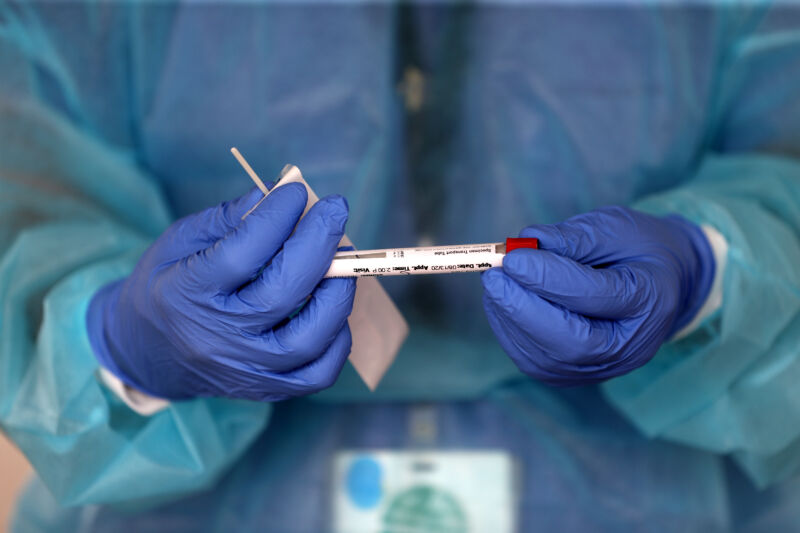Big questions —
It may be rare, but it highlights how much we have to learn about COVID-19 immunity.
Beth Mole
–

Enlarge / A nurse practitioner administers COVID-19 tests in the parking lot at Brockton High School in Brockton, MA under a tent during the coronavirus pandemic on Aug. 13, 2020.
A 25-year-old resident of Reno, Nevada was infected with the pandemic coronavirus, SARS-CoV-2, two times, about 48-days apart, with the second infection causing a more severe case of COVID-19 than the first and requiring hospitalization and oxygen support.
That’s according to a draft study, led by researchers at the University of Nevada and posted online. The study has not been published by a scientific journal and has not been peer-reviewed. Still, it drew quick attention from researchers, who have been examining data from the first confirmed case of a SARS-CoV-2 reinfection, reported earlier this week.
Reinfections with SARS-CoV-2 are not surprising—or even necessarily concerning. From person to person, immune responses to an infection develop along a spectrum, with some people mounting robust, protective responses and others being left with weaker responses. Amid the more than 24.5 million cases worldwide, it is completely expected to find some recovered patients who are not completely protected by their immune responses and are thus vulnerable to reinfection.
The big question is: how common is this scenario? Researchers still do not know. This case may very well represent a very rare event, but there are many massive questions about SARS-CoV-2 immune responses that researchers are racing to understand. Why do some people develop more severe disease than others? For those who recover, what levels of immune responses will protect them from another infection? How many of the recovered will develop those protective responses? And how long do those protective responses last?
While the new report of a reinfection is an important data point, it—like the reinfection report before it—does not answer any of these big questions.
Genetic detective work
About all we can say from these reports is that reinfection is possible—at least for some individuals. Again, this isn’t surprising, but it is tricky to prove. Like the report earlier this week, the Nevada researchers turned to whole genome sequencing as evidence that their patient did indeed have two, distinct infections.
Specifically, the researchers decoded the entirety of the SARS-CoV-2 genetic material collected from nasal swabs taken during the first and second illness. The researchers found that viruses present in the patient’s nose during the two illnesses had many small differences in their codes. The first virus had four code variations missing from the second—and the second virus had seven variations missing from the first. While small genetic changes tend to naturally accumulate in viruses over time, the researchers calculated that if the two illnesses were actually caused by the same virus, the virus would have had to evolve more than 3.6-times faster in this one patient than has been previously documented. Moreover, four of the changes seen between the two viruses could only be explained by genetic “reversions,” and the odds of these occurring are “vanishingly remote,” the authors say.
Still, aside from the genetic evidence suggesting two different infections, there’s always the question of whether there was some mix-up with the samples. That is, perhaps the patient did not have the different strains of virus plucked from their nose; perhaps the swabs were simply mislabeled or mishandled in the lab. To try to head off this concern, the researchers did genetic forensic testing on the liquid in which the swabs were stored and intermediate sample preparations. The researchers found that all the human-derived material scraped up and associated with the nasal swab samples came from the same person.
Holes in immunity
While the researchers make a persuasive case that their patient was in fact infected twice, critical data about the patient’s immune responses are missing. Most notably, the researchers did not test for antibodies after the person’s first infection in April, which was marked by sore throat, cough, headache, nausea, and diarrhea. So, although data so far suggests that most people develop antibodies that can help protect against SARS-CoV-2 after an infection, the researchers don’t know if this patient did or not. They do note, however, that the patient was not immunocompromised and did not appear to have a condition that would make reinfection seem more likely.
In the first report of a reinfection in a Hong Kong man, researchers tested for antibodies at one point after the patient’s first infection, but they didn’t find any. Though this hints that the person may not have developed antibodies (which could explain the reinfection), the researchers say they would need more testing at different time points to definitely show a lack of antibodies after the first infection. Importantly, the Hong Kong patient’s second bout of COVID-19 was asymptomatic, suggesting that he did have some protective immune responses.
The Nevada patient wasn’t so lucky. In the second infection that began in late May, the patient developed shortness of breath and a cough. Lung scans later showed signs of atypical pneumonia. The person was hospitalized and required ongoing oxygen support. In early June, the patient tested positive for SARS-CoV-2 antibodies, but the researchers did not closely examine the types of antibodies.
In all, this case, like the first, leaves all the big questions unanswered. As Yale immunology expert Akiko Iwasaki summarized: “This case highlights the need for further examination of the range of outcomes from reinfection by COVID19. As more and more reinfection cases will be reported, we should get a better sense of how well the immune system after natural infection protects against disease.”

